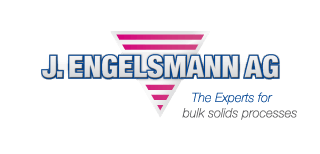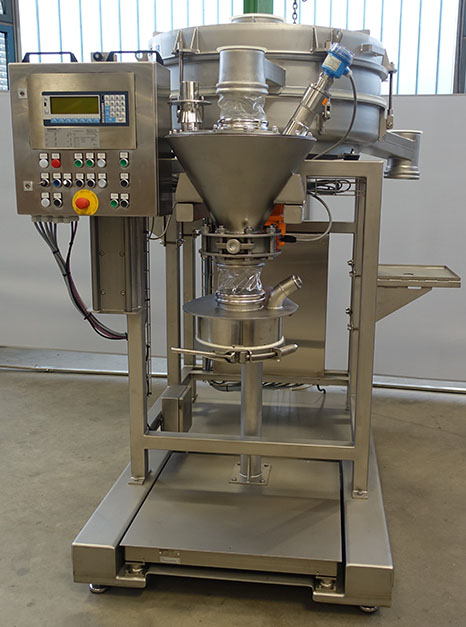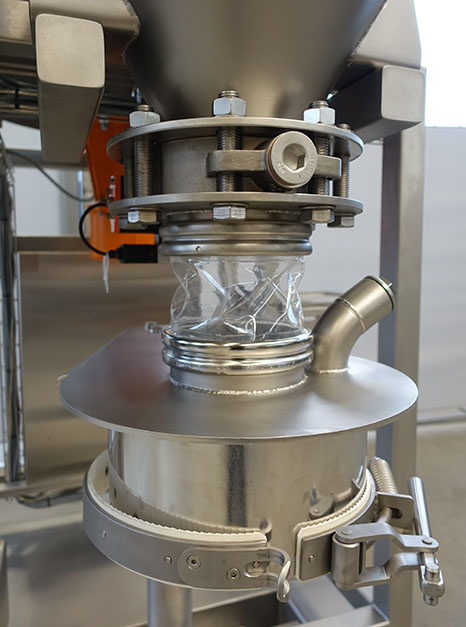- Sectors ›
- Article: Dosage for small quantities of product
Mobile filling station increases flexibility
20.04.2018
Mobile filling station for large and small containers
For many producers whose goods are destined for sale, there is not always a clear solution when it comes to finding the right packaging for their products. Even if big bags are the most commonly used method of transportation and storage, with their filling capacity of 1,000 to 1,500 liters, they are not always suitable for every customer. Big bags are often oversized for smaller operations or customers that want to test a smaller amount of product beforehand. In most production facilities there is not much space, and for some companies setting-up their own production line with a small package filling system attached is often not worth it. A manufacturer of plastic granulates was also faced with this challenge as they regularly got requests for smaller product quantities but they were unable to optimally serve their customers. Therefore, J. Engelsmann AG constructed a mobile filling station for small packages that can easily be installed in existing big bag filling stations.
Until now, the operator only included big bag filling stations at the end of his manufacturing processes to weigh and package the plastic granulates. Requests for smaller quantities of product could either not be processed or they could be processed but it would take more time and work as the packages had to be filled by hand. A small package filling station for packaging materials with a filling capacity of 20 liters should remedy this problem in the future. The challenge: Converting one of the existing filling lines was out of the question for the operator as there was not a large enough demand for smaller quantities. Instead, the operator wanted to retain the capacity of the existing big bag stations and only convert it for small package filling when needed. Something that was particularly important to the customer was keeping the time needed to convert the system to small packages as low as possible so that they could react to the customer's requests as quickly as possible. In addition, the conversion itself needed to be as uncomplicated as possible and designed so that it could be easily done by all operators. As a solution, J. Engelsmann AG created an independent filling station which is perfectly tailored to the size of the big bag station and could be easily configured to add-on to this.
Multiple functions in a small space
The base frame is the base of the new filling unit. In this outer frame, there is the actual filling unit consisting of platform scales with a filling stand and head, to which the empty packages are connected. Thanks to the integrated forklift access, the filling station can be quickly transported from A to B and is not restricted to one fixed place. As soon as it needs to be converted to a small-package filling station, the filling station is picked up by a forklift and transported to one of the existing big bag stations. First of all, the available big bag filling head and the leading gear need to be removed before the base frame of the small-package filling station can be put on the big bag station U scales.
Unlike with the big bag filling, the material to go in the small-packages is first conveyed over a screening machine before it is packaged. The integration of a screening stage to remove any oversized and fine particles from the plastic granulates before being packaged was one of the operator's most important process requirements. This task is now performed by a round screening machine with two screen inserts which was installed on the machine base and functions as a control screen. However, depending on the further processing procedure of the customer, separating the small particles is not always required. If there are no limit values specified regarding this, the operator can simply replace the second screen insert with a dummy plate so that only two groups will be screened off: the correctly sized particles and the oversized particles. To prevent the mesh becoming clogged with stuck particles during the screening, the round screen is additionally equipped with an ultrasound cleaning system. This type of screen cleaning moves the screen mesh with an ultrasound frequency so that the stuck particles are removed. The granulate that has been freed from oversized and fine particles flows through the screen via the correctly-sized particle outlet and through a BFM sleeve into the product collection container below. A level indicator continuously measures the amount in the container so that it is not overfilled or run dry. The granulate eventually flows from the collection container to the filling head, via an additional BFM sleeve, and into the connected small package. Both the filling head and the product collection container are connected to the integrated aspiration system to ensure a particularly low-dust material feed. To fill the selected package, the operator simply has to enter the desired quantity into the height-adjustable operating panel. The filling process lasts until the scales give a signal that the set weight has been reached. An pneumatically-operated shut-off valve, which can be found beneath the collection container, then closes automatically and stops the filling. The operator can now open the filling head bag clasp and remove the filled package. Thanks to the high degree of automation, the operator can achieve a throughput of up to 1,000 kg, a volume that could have never been achieved if they had to fill the packages manually by hand. All parts of the machine that come into contact with the product are made from stainless steel (1.4571 and 1.4404) and are smoothed and polished to a surface roughness of 0.6 μm. All other parts are made from V2A.
Conclusion: The expansion of production with small-package filling offers the customer numerous advantages. Requests for small quantities of product can be dealt with problem-free and the filling of product samples is also more efficient. This means that these samples can now be used as a sales instrument, e.g. for acquiring new customers, more often. Thanks to it being introduced as a mobile expansion of the already existing big bag stations, an expensive conversion of the production process was not necessary. The set-up of the additional small package filling station could be done with almost no downtime and stops in production. Through the simple connection of the small package filling station to the big bag stations, the operator can also react quickly to customer requests and convert their production accordingly - without the permanent connection of an additional filling station.









